#Hakam
Text
Fifth part of the bookscans of Al Andalus. Historical Figures, here's the previous part
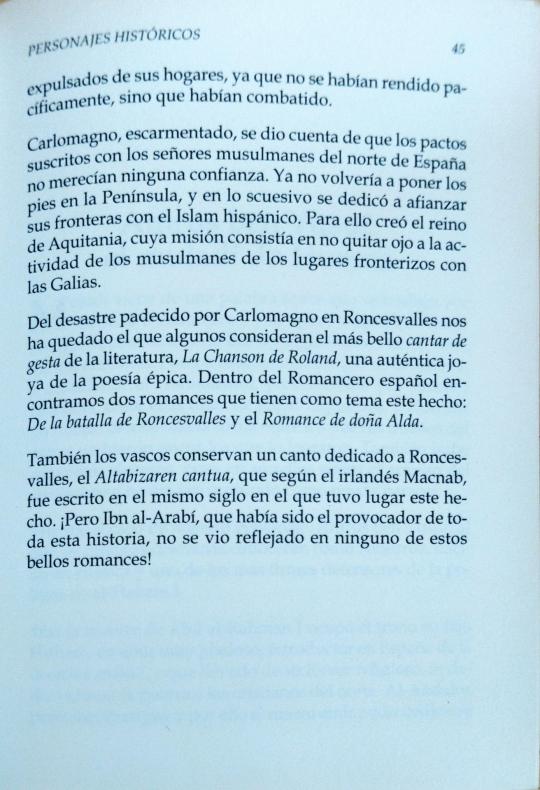
expelled from their homes, since they had not surrendered peacefully, but had fought.
Charlemagne, chastened, realized that the pacts signed with the Muslim lords of northern Spain deserved no trust. He would never set foot on the Peninsula again, and subsequently dedicated itself to strengthening its borders with
Hispanic Islam. For this he created the kingdom of Aquitaine, whose mission
consisted of not taking our eyes off the activity of the Muslims of the
places bordering Gaul.
From the disaster suffered by Charlemagne in Roncesvalles we have
remains what some consider the most beautiful song of deeds of literature, La Chanson de Roland, an authentic gem of the epic poetry. Within the Spanish Ballads we find two romances that have this fact as their theme: Of the battle of
Roncesvalles and the Romance of Doña Alda.
The Basques also preserve a song dedicated to Roncesvalles, the Altabizaren cantua, which according to the Irishman Macnab, was written in the same century in which this event took place. But
Ibn al-Arabí, who had been the originator of this whole story, was not reflected in any of these beautiful romances!
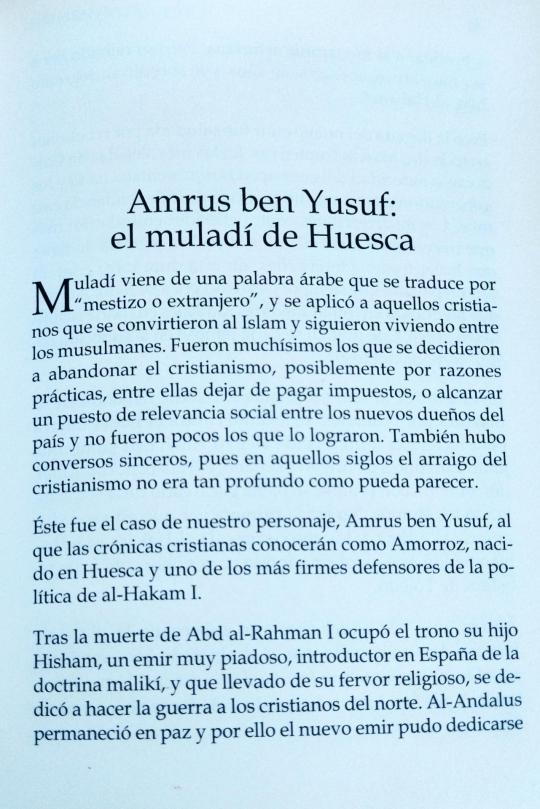
Amrus ben Yusuf:
the muladí of Huesca
Muladí comes from an Arabic word that translates as "mixed race or foreigner", and was applied to those Christians who converted to Islam and continued living among the Muslims.
There were many who decided
to abandon Christianity, possibly for practical reasons, including stopping paying taxes, or reaching a position of social relevance among the new owners of the country and there were not a few who achieved it. There was also sincere converts, since in those centuries the roots of the Christianity was not as deep as it may seem.
This was the case of our character, Amrus ben Yusuf, whom the Christian chronicles will know him as Amorroz, born in Huesca and one of the staunchest defenders of the policies of al-Hakam I.
After the death of Abd al-Rahman I, his son Hisham, a very pious emir, introducer of the Maliki doctrine in Spain, and who
Driven by his religious fervor, he dedicated himself to waging war on the Northern Christians. Al-Andalus remained at peace and therefore the new emir was able to dedicate himself
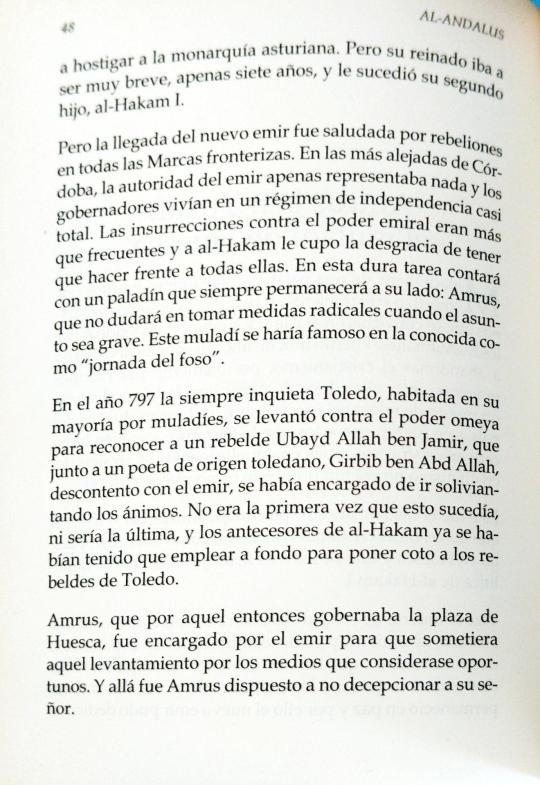
to harass the Asturian monarchy. But his reign was to be very short, just seven years, and was succeeded by his second son, al-Hakam I.
But the arrival of the new emir was greeted with rebellions in all the border marches. In the most remote areas of Córdoba, the authority of the emir hardly represented anything and the governors lived in a
regime of almost total independence. The insurrections against the power of the emirate were more than frequent and al-Hakam had the unfortunate luck to have to face them all. In this hard task, he will have a paladin who will always be at his side: Amrus, who will not hesitate to take radical measures when the matter is serious. This muladí would become famous on what was known as the “day of the pit.”
In the year 797, the always restless Toledo, inhabited mostly by muladíes, rose up against the Umayyad power to recognize a
rebel Ubayd Allah ben Jamir, who together with a poet of Toledo, Girbib ben Abd Allah, dissatisfied with the emir, had
in charge of calming down the spirits. It wasn't the first time this happen, nor would it be the last, and al-Hakam's predecessors had already had to work hard to put a stop to the rebels of Toledo.
Amrus, who at that time ruled the stronghold of Huesca, was commissioned by the emir to subdue that uprising by the means that it considers opportune. And there went Amrus willing not to disappoint his lord.
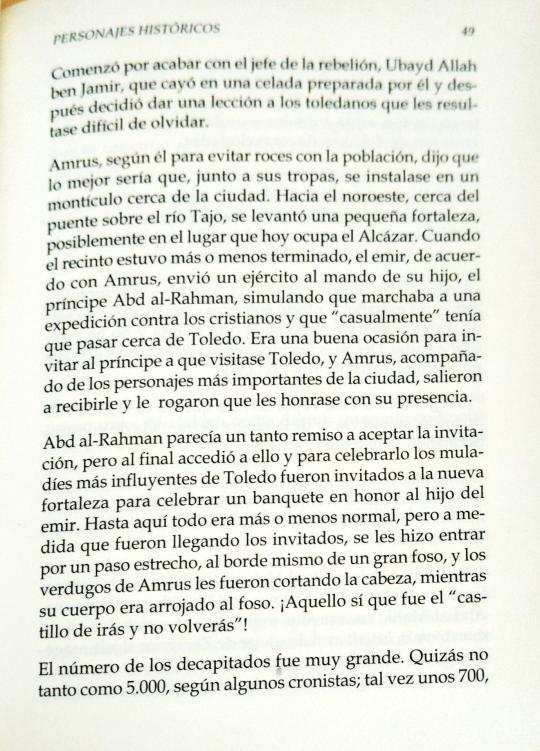
He began by eliminating the leader of the rebellion, Ubayd Allah ben Jamir,
who fell into a trap prepared by him and then decided to give a lesson to the people of Toledo that they would find difficult to forget.
Amrus, according to him to avoid friction with the population, said that the best
would be that, along with his troops, he would settle on a mound near the
city. Towards the northwest, near the bridge over the Tagus River, rose
a small fortress, possibly on the site now occupied by the Alcazar. When the enclosure was more or less finished, the emir, in agreement with Amrus, he sent an army under the command of his son, the prince Abd al-Rahman, pretending that he was going on an expedition against the
Christians and that "coincidentally" had to pass near Toledo. It was a good occasion to invite the prince to visit Toledo, and
Amrus, accompanied by the most important people of the city, they came out to receive him and begged him to honor them with his presence.
Abd al-Rahman seemed somewhat reluctant to accept the invitation, but
In the end he agreed to it and to celebrate it the most influential mula-díes
of Toledo were invited to the new fortress to celebrate a banquet in honor of the emir's son. Until then everything was more or less normal, but as the guests arrived, they became enter through a narrow passage, at the very edge of a large ditch, and the Amrus's executioners cut off their heads, while their bodies was thrown into the pit. That was the " castle of you will go and no you will come back"!
The number of those beheaded was very large. Maybe not as much as
5,000, according to some chroniclers; maybe about 700

being a very high number. What the leading class of Toledo was thus beheaded and the terrible impression produced by this event remained, for a long time, both among the Muslims and among the muladies of Toledo and from other cities.
Dozy narrates that terrible day like this: "At daybreak, a doctor that had not seen anyone leave through either of the two door, became suspicious and asked the people gathered near the entrance of the castle what had happened to the guests who had arrived early.
"They must have gone out through the other door," they answered- It's strange!-the doctor then objected -; I have been for some time at the other door and I haven't seen anyone leave. After watching the steam rising above the walls,
exclaimed:
Unfortunates! I swear to you that this vapor is not the smoke of a feast,
but the vapor of the shed blood of your brothers, beheaded"
When things got really bad, al-Hakam knew that he could count on Amrus and so he also entrusted him with the submission
of Zaragoza, the capital of the Upper March, as seditious as Toledo.
After the advent of al-Hakam, the two best generals of his father, Abd al-Karim ben Mugith and his brother, Abd al-Malik, in
those moments at enmity with the new emir, they tried to evict the Aragonese chief Bahlul ben Marzuq from Zaragoza, to
They settled in the city, but they did not succeed. He got a Cordoban army, and
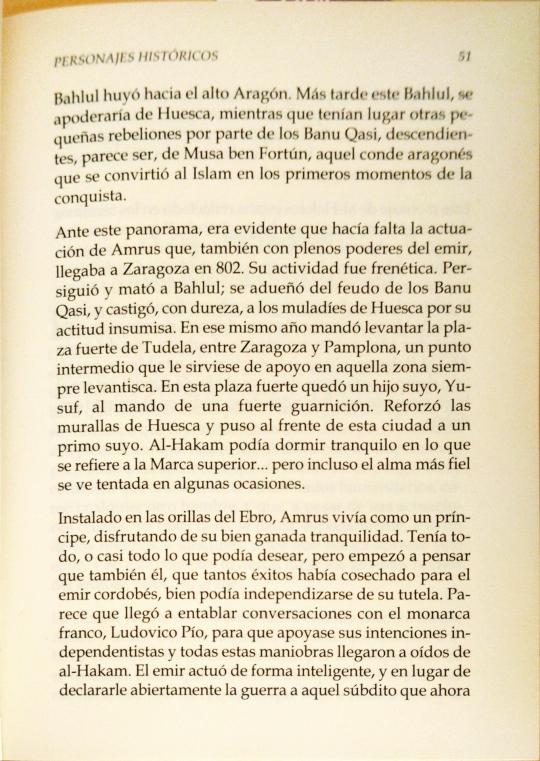
Bahlul fled towards upper Aragon. Later this Bahlul, would take over Huesca, while other small rebellions by the Banu Qasi took place, who were descendants, it seems, of Musa ben Fortún, that Aragonese count who converted to
Islam in the first moments of the conquest.
Given this panorama, it was evident that the action of Amrus who, also with full powers of the emir, came to Zaragoza in 802. Its activity was frenetic. Persecuted and killed Bahlul; took over the fiefdom of the Banu Qasi, and harshly punished
to the muladíes of Huesca for their rebellious attitude. In that same
year he ordered the construction of the stronghold of Tudela, between Zaragoza and Pamplona, an intermediate point that would serve as support in
that always upheaval area. In this stronghold there was his son, Yusuf, commanding a strong garrison. He reinforced the walls of Huesca and put one of his cousins in charge of this city.
Al-Hakam could sleep peacefully when it came to the Upper March... but even the most faithful soul is tempted in some
occasions.
Installed on the banks of the Ebro, Amrus lived like a prince, enjoying your well-earned peace of mind. He had everything, or almost everything he could want, but he began to think that he too,
which had garnered so much success for the emir of Cordoba, could become independent of his tutelage. It seems that he came to engage conversations with the Frankish monarch, Louis the Pious, so that
supported their independence intentions and all these maneuvers reached al-Hakam's ears. The emir acted
intelligent, and instead of openly declaring war on that subject that now
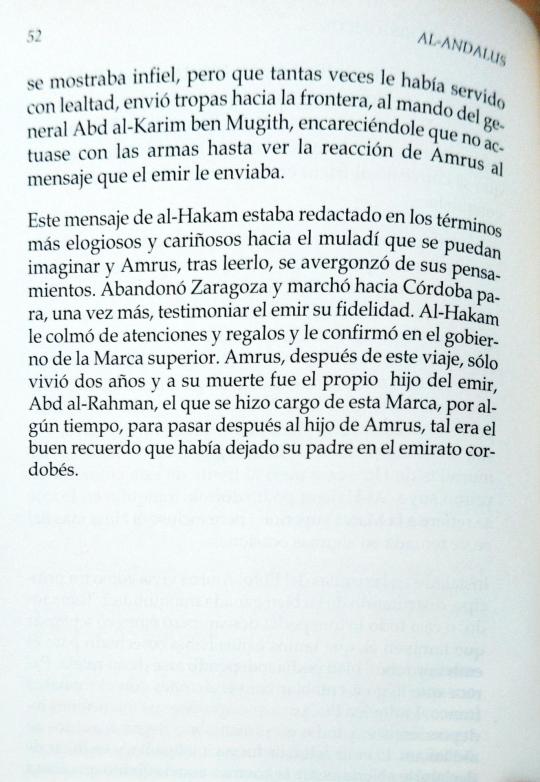
showed to be unfaithful, but that he had served him so many times with loyalty, he sent troops to the border, under the command of General Abd al-Karim ben Mugith, urging him not to act with the
weapons until seeing Amrus's reaction to the message that the emir gave him.
This message from al-Hakam was written in the most praiseworthy and affectionate towards the muladí that you can imagine and Amrus, after reading it, was ashamed of his thoughts. He left Zaragoza and marched towards Córdoba to, once again, bear witness the emir his fidelity. Al-Hakam showered him with attention and gifts and confirmed him in the government of the Upper March. Amrus, after
of this trip, he only lived two years and at his death the son of the emir, Abd al-Rahman, took charge of this March, for
some time, to later pass to the son of Amrus, such was the good memory that his father had left in the emirate of Cordoba.
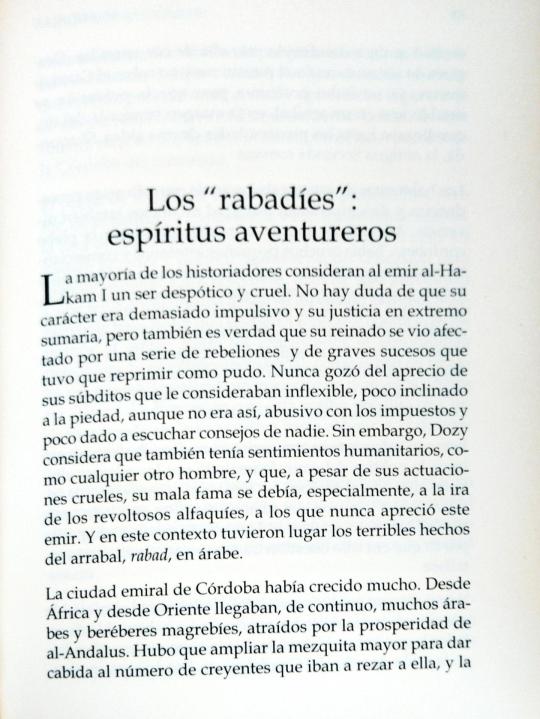
The "Rabadis":
adventurous spirits
Most historians consider the emir al-Ha-kam I despotic and cruel. There is no doubt that his character was too impulsive and his justice extremely summary, but it is also true that his reign was affected by a series of rebellions and serious events that he had to repress as best he could. He never enjoyed the appreciation of his subjects who considered him inflexible, little inclined to piety, although it was not like that, abusive with taxes and little given to listening advice from no one. However, Dozy believes that he also had humanitarian feelings, like any other man, and that, despite of his cruel actions, his bad reputation was due, especially, to the
wrath of the rebellious alfaquis, whom this emir never appreciated. And in this context, the terrible events of the suburb, rabad in Arabic, took place.
The emiral city of Córdoba had grown a lot. From Africa and from the East any Arabs and Berbers from the Maghreb continually arrived attracted by the prosperity of al-Andalus. The mosque had to be expanded larger to accommodate the number of believers who came to pray to it, and

The city was expanding beyond its walls. After the Roman bridge over the Guadalquivir was restored, there was no longer a problem for the population to settle in a suburb on the left bank of the river, which reached the vicinity
from a village, Shaqunda, ancient Roman Secunda.
The inhabitants of this suburb were of very diverse origins and they carried out a multitude of diverse jobs. Besides
of what could be considered the Cordoba plebs, there were many small Mullawad and Christian artisans and merchants, but
due to its proximity to the main mosque and the emiral palace, many Cordobans who were employed, either in the mosque or in the palace, they settled there. Among this diverse population, also found the alfaquíes, religious leaders of the doctrine
Malikí, who had reached a very prominent position and a very notable influence at court, especially with the emir
Hisham, father of al-Hakam I.
This suburb will soon become a focus of discontent towards the emir's policy, promoted by the same alfaquies who with
al-Hakam had neither the appreciation nor the influence that they achieved with
his predecessor. On the other hand, in the city al-Hakam did not enjoy of many sympathies so it was only a matter of time before the situation exploded.
And it happened that one day a rumor spread through the city that seventy-two leading citizens had been executed and that their corpses were going to be exposed, crucified, on the right bank
of the Guadalquivir. The mood be-

gan to exalt, without knowing or without asking themselves the reason for these executions. What happened was that a plot had been hatched to overthrow the emir
and put in his place one of his cousins, the Umayyad Muhammad ben al-Qasim. Many notable people from the Córdoba of that time were involved in this conspiracy.
Al-Hakam's cousin pretended to accept the proposal, but was immediately
to tell the emir, also providing him with the list of the conspirators. Inthat same day, the emir ordered them to be arrested and executed, taking advantage of the
occasion to order the murder of two of his uncles, sons of Abd al-Rahman I, who had been imprisoned since his ascension to the throne, possibly to prevent them from rebelling against him or challenging him for power. Between the crucified were figures of great social relevance, such as the
son of a cadi, a palace eunuch, a market inspector and even a alfaqui. The impression that this action produced in Córdoba could not be more negative towards the emir, and the discontent, already notable, increased.
There was a plotting everywhere, at any time of the day. In the mosques, in the markets, in the streets discontent was chewed, while everyone distrusted everyone, believing they saw spies and
confidants of the emir throughout the entire city.
Al-Hakam, aware of the mood, equipped himself withweapons, restored the walls, surrounded himself with a strong personal guard under the command of a Christian, Count Rabí, and prepared himself for the worst.
#book scans#al andalus. historical figures#al andalus. personajes históricos#al andalus#al andalus history#bookblr#historyblr#spanish history#sulayman ibn yaqzan ibn al-arabi#amrus ibn yusuf#rabadies#rabadi#al hakam i#al hakam i of córdoba#emirate of cordoba#umayyad emirate of córdoba#middle ages#rabadid dinasty#hisham i#hisham i of cordoba
9 notes
·
View notes
Video
youtube
Hakam Din Sheesham Bagpipe drones, Warnock Chanter Shepherd chanter reed.
#youtube#Hakam Din#Pakistan#Pakistani#Bagpipes#Pakistani Bagpipes#Scotland#Scottish#Ireland#Irish#Celtic#Tradition#Music#DIY#American#America#USA#United States#United States of America#Australia#Australian#New Zealand
29 notes
·
View notes
Photo






Almanzor and Subh
Subh was originally a Christian woman from Navarre by the name Aurora. When she was just a child, was sold as a slave in the territory of Al-Andalus becoming part of the harem of the Caliph of Córdoba Al-Hakam II. She was given an exquisite training, from singing to Islamic jurisprudence to poetry, that was only available to women of the highest status and slaves. The duty of the slaves, as part of the harem, was to entertain powerful men with their songs, dances and cultured conversations. Blonde, tall and intelligent, Subh captured the Caliph’s attention becoming his favorite and wife. Subh gave her husband two sons: Abd al-Rahman (born 961 and deceased in 970) and Hisham (born 965).
In the later years of his reign, the Caliph lost interest of the routine management of political affairs, and reportedly left it to his favorite wife, Subh. To fill this task, she expressed the need for a secretary, and Al-Mansur Ibn Abi Amir (also known as Almanzor) was appointed to this post. Born in an alqueria on the outskirts of Torrox to a family of Yemeni Arab origin with some juridical ancestors, Almanzor left for Córdoba when still young to be trained as a faqīh. After a few humble beginnings, he joined the court administration and soon gained the confidence of Subh. The Caliph was surprised that his wives and concubines preferred the gifts of the young Almanzor to his own. There were rumors that Almanzor became Subh’s lover and that this was the reason why she was to give him such influence in the affairs of state.

In 976, Al-Hakam died and was succeeded by his son, the eleven-year old Caliph Hisham II, under the regency of Queen mother Subh, the first minister Jafar al-Mushafi, and Almanzor, who became the administrator of the properties left to Subh by Al-Hakam. It was only a matter of time before rivalries and alliances started to form between the three regents. Subh sought an alliance with Almanzor. They managed to eliminate the influence of the minister. Reportedly, Subh provided Almanzor with the necessary funds to give him control of the army, by which he could secure the stability necessary for her son, a child, to be secured as Caliph with her as regent, after which she gave him much power in her government.
The collaboration between Subh and Almanzor reportedly worked completely well, friendly and close until 986, but as Almanzor power grew and the caliph's isolation, Subh became extremely concerned, and their alliance and effective rule began to disintegrate in 996, when a conflict arouse between them, because Almanzor was so ambitious, he angered Subh and her other allies, putting him in front of her and her allies. This conflict, causing Subh to an unsuccessful attempt to depose Almanzor from his position by introducing other male favorites as his rivals. During two years of bloody rivalry only for their own power, they created divisions in the center of the caliphate. Her second and last attempt to depose him in 998 resulted in his complete accession of all power, and ended her rule. Hisham II was locked up – with all the comforts but without power – in Medina Alzahira, where his mother was probably also imprisoned. Having lost her confrontation with her former ally, Subh died shortly thereafter in 999. Almanzor was the de facto leader of the Caliphate of Córdoba until his death in 1002.
22 notes
·
View notes
Text
put in a yasuko commission with an artist who’s work i really like, pulling the refs was honestly helpful in figuring out their style. yasuko 🤝 utahime, wearing hakama and not the skirt/pants uniform.
3 notes
·
View notes
Text



He looks so cool!
#welcome to demon school iruma kun#mairimashita! iruma kun#m!ik#mairuma#mairimashita iruma kun#iruma kun#suzuki iruma#read ware ware da its good#makai no shuyaku ware ware da#ware ware da#we are the main characters of the demon world#teufel shaoron#hakam white tail#spoliers
15 notes
·
View notes
Text
Bote de Fátima (MAN)
Bote de marfil, realizado el año 964 (353 de la Hégira), procedente de la Catedral de Zamora.
Continue reading Bote de Fátima (MAN)
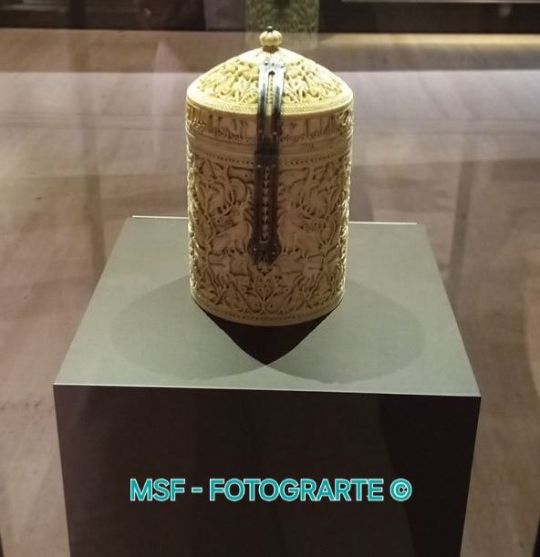
View On WordPress
#Al-Hakam II#Arte islámico#Artes decorativas#Córdoba#Edad Media#España#Medina Azahara#Museo Arqueológico Nacional (Madrid)#middle ages#Madinat al-Zahra#Spain#Fine arts
2 notes
·
View notes
Text






this movie is pathological
#w.what do you mean he fell on his own knife. you jumped on him?!?!#honestly fuvk curly jude AND laurey... stan will ali hakam and ado annie tho#oklahoma! x st
2 notes
·
View notes
Text
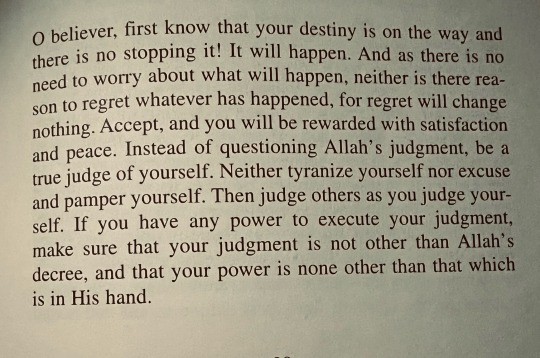
this made me feel good tonight 💌✨ Alhamdulilah ❤️
#personal#AL-Hakam#99 names of allah#the name and the named#beautiful#islam#He is the one who orders
12 notes
·
View notes
Text

@/folkoftheshelf on Twitter has made a thread of fundraising links for Gazans. I’ve transferred the links here, please boost them as the conflict is worsening:
Help Ahmad Hassan and his family escape Gaza
Help Halla Morshed’d family escape Gaza
Help Dr. Yousef Alsweisi and his family escape Gaza
Evacuate Sohad’s family out of Gaza
Help Donia Tanani and her family escape Gaza (they are close to reaching their goal!!)
Help Zinh and her family escape Gaza (they are close to reaching their goal!!)
Help this Gazan family rebuild their lives (they are not close to their goal as of writing)
Help the Zack Family
Help Hala Jad and her family (they are at a 1/3 of their goal)
Help Walid and his family escape Gaza (they are close to reaching their goal!!)
Help Mariam Radi and her family (as of right now they are not close to reaching their goal)
Help Maha Abu Shammala evacuate the family from Gaza (they haven't met their goal as of writing)
Help Ronza Alaa and her family (they haven't met their goal as of writing)
Help Noor and her family evacuate to safety (they haven't met their goal as of writing)
Help Manar Abuqata get his family out of Gaza (goal hasn't been met as of writing)
Help Farah save her family
Help Ahmad’s family escape from Gaza to Egypt
Help evacuate Mohammed Harara’s family out of Gaza (they are halfway through their goal!!)
Help Dana and her family escape (they have almost met their goal!!)
Help Anas’ family escape from Gaza (goal has not been met as of writing, note that the money is in krona, 1 usd=11 krona)
Help Ibrahem Ra’fat Daher and his family evacuate Gaza
Help Hakam Albalawi save his family (goal had not been met as of writing)
Help Tabseem AbuJamie’s family evacuate (goal hasn't been met and only has two donations as of writing)
Rafah Masterpost
#Sumechiaspeaks#Palestine#Gaza#Free palestine#Free gaza#Mutual aid#Aid#Donation#Donations#Gofundme#Fundraiser#Donate#Please spread this around its getting worse and worse
30K notes
·
View notes
Text
Momen Anies dan Fery Melepas Anaknya Sekolah ke Manchester
JAKARTA | KBA – Putra ketiga pasangan Anies Baswedan dan Fery Farhati, Kaisar Hakam Baswedan melanjutkan sekolah ke Kota Manchester, Inggris.
Dalam video #CeritaFery yang diunggah di akun Instagram Fery Farhati, dia menceritakan bahwa di dalam keluarganya memiliki sebuah tradisi untuk mendoakan dan mengantarkan anak-anaknya yang akan berangkat studi.
“Kaisar akan melanjutkan sekolah ke…

View On WordPress
0 notes
Text

Somewhere, someone is praying for you.
They are asking As-Salam (The Giver of Peace), to give you nothing but peace.
They are asking Al-Ghafoor (The Forgiving), to forgive all of your sins.
They are asking Ar-Razzaaq (The Provider), to provide you with everything you need.
They are asking Al-Hakam (The Giver or Justice), to guide those who have betrayed you.
They are asking Al-Hafeedh (The Protector), to protect you from anyone who doesn't have good intentions towards you.
They are asking Al-Mujeeb (The Responsive One), to answer all of your duas.
Be patient like As-Saboor (The Patient).
Soon their prayers for you will be answered.
And so will yours.
313 notes
·
View notes
Text
6th part of the bookscans of Al Andalus. Historical Figures, here's the previous part

The following year a very serious incident occurred in the suburb, and according to
custom, al-Hakam acted summarily, executing all possible guilty suspects
through the infamous crucifixion.
As if that were not enough, the mood of the population in general, an increase in
the taxes that, on top of that, a Christian, the so-called Count Rabi, collected, ended up for exasperating everyone. And the spark of rebellion broke out over an apparently trivial matter, as happens on so many occasions. A soldier of the guard
emir had his sword polished and it seemed to him that the swordsmith in the suburb did not attend to him with sufficient alacrity, so he killed him by piercing him with his sword in question. Al-Hakam was hunting outside Cordoba and upon returning, passing through the conflictive neighborhood, was booed. His guard arrested ten rioters and, without mercy, they were immediately crucified. The emir had barely arrived at his palace when the entire suburb was up in arms. Businesses were closed and the tents, and with sticks, stones, knives, and everything they had within their reach, artisans, merchants, and the general public headed to the doors of the Alcázar with threatening intentions and the design of demolishing them.
In those moments of anguish in the Alcázar, when his fate presented itself
doubtful in the face of those angry mobs, only al-Hakam seemed to retain the
calm. He asked his Christian page to fetch a jar of civet and with it he perfumed his hair and beard. The page asked him, astonished, how in those serious moments he could think of putting on perfume as if he were going to court a woman and the emir replied that he did it so that when the popu-

lace cut off his head to know that it was really the head of their prince and not that of any other.
Measures were taken with all the speed that the committed moment required. The troops loyal to the emir ensured order in the city and the palace butler and his secretary gathered all the available forces to try to contain the rapidly advancing mobs that were leaving uniting more and more people. The emir's troops were beginning to falter in the face of what
seemed an unstoppable force of the mutineers, until two of the generals
from al-Hakam they managed to reach the first houses in the suburb. Then its
inhabitants found themselves surrounded. The two exits of the neighborhood were taken by loyal to the emiral cause. The rout began... and the slaughter.
Al-Hakam gave orders that no mercy be shown to the rioters and for three the looting and massacre continued, and no one knows what it could had happened if the minister Ibn Mugith did not advise the emir to cease in that horrible carnage. The suburb was closed so that no one could leave there until al-Hakam passed sentence or thought about what to do with the rebel subjects. The solution was still terrible, as terrible as three hundred
notables of the suburb would be crucified and the rest of the inhabitants who had
survived would preserve their lives in exchange for immediately abandoning
Córdoba. The suburb would be completely demolished, plowed and planted so that no one could build a house or a habitation there. None of al-Hakam's successors dared, until the end of the 10th century, to contravene that now distant prohibition dictated by the emir and the suburb remained, for

a long time, like a desolate and dead place in which it seemed impossible there would have been so much life.
The inhabitants of the suburb, "rabadis" as they would be known, had to abandon
house, business and city in the first fortnight of April 818. Only the fuqahāʾ and their families were freed from this expulsion, much to the dismay of al-Hakam, knowing as he knew that if they had not been the direct instigators of the rebellion, they encouraged it and did nothing to calm things down.
It is not well known how many people were banished from the suburb, it is believed that perhaps there were about 20,000, since it was a very populous neighborhood, although the figure may have been a bit exaggerated. And there begins the odyssey of the “rabadis”, who showed themselves to be accomplished adventurers, forced, no doubt, by the
need.
Some went to take refuge in Toledo, a city always willing to welcome to all those who showed themselves against the central power. But they feared that the anger of that vengeful emir reached them, so they decided to flee further away, as far as to cross the sea. The Rabadis, with their families, left towards the Mediterranean coast, not without suffering the assault of the unscrupulous in their modest convoys in which they carried the few belongings they saved from the merciless looting to which they had already been subjected.
Some went to North Africa and settled among the Berber tribes. In this region there were few cities and Prince Idris II was looking for inhabitants who could populate the city of Fez that their father had founded. It would not

take much time to increase this population with a new city, very close to the one that already existed and spread the word that everyone who came to populate both cities
would be welcomed with open arms. Many Rabadis, with their families, moved there and very soon the new foundation of Idris II was known as Madinat al-Andalusiyyin, the “City of the Andalusians”. To this city they took the rabadis their knowledge of gardening and agriculture, crafts and architecture, as well as as their forms of citizen life. But this was not their greatest feat of those banished.
Part of them set out to sail the Mediterranean, dedicating themselves to privateering and piracy to survive. Although the Rabadis were not sailors, it is very possible that they they were accompanied by Valencian or Andalusian sailors, muladíes most likely, and that together they would undertake that adventure.
One day they docked in front of beautiful Alexandria, in those days subjected to fighting, that were taking place throughout Egypt, among the governors appointed by the caliph. The Rabadis became strong in the city and with the help of a faction
Arab, the Lajmis, and the followers of a puritan Islam, created a kind of
independent republic that they would maintain for more than ten years.
In vain the inhabitants of Alexandria tried, on more than one occasion, to get rid of
these upstarts who had become masters of their city. Finally, in May 827, the governor Abd Allah ben Tahir, besieged them and after several days of siege, the
Rabadides surrendered. They were allowed to go, but

they could not take any of their slaves and had to compromise that they would not dock in any port that was in Abbasid territory.
Thus they found themselves expelled from Egypt, as they had already been expelled from Córdoba, and they began the journey again, this time heading towards the island of Crete, which belonged to the Byzantine Empire. In command of that expedition that sought a place to settle, there was a man from Córdoba from Llano de los Pedroches, called Abu Hafs Umar al-Balluti. They landed on the island and occupied it in their whole. Abu Hafs al-Balluti founded a dynasty there that remained on the island for one hundred and thirty-four years, until the year 961.
They repelled incessant Byzantine attacks that wanted to recover Crete, until
that the general Nikephoros Phocas managed to recapture the island for the Byzantine emperor Roman II.
Back at sea, those already distant Andalusians, for more than a century and
medium, frightened the entire navigation of the central and eastern Mediterranean,
also acting with great audacity in the Aegean islands.

Ziryab: the singer of Baghdad
A somewhat peculiar character from Muslim Spain was Ziryab, although he wasn't a politician, nor a religious person, nor a warrior, he was going to have a capital influence on the Andalusian society, creating fashions and implementing customs and ways of life that ended up adopting Moors and Christians, and that would remain until our days.
Ziryab was called that because he had very dark skin and he was given this nickname in reference to the black plumage of a bird, the blackbird, but its real name was
Abu-l-Hasan Ali ben Nafi. He was born in Mesopotamia and was a freedman of the Abbasid caliph al-Mahdi. From a very young age he showed to be gifted, in a privileged way, for singing and was a disciple of another celebrity in the field of music, the singer of the Baghdad court, Ishaq al-Mawsilí. Very soon he became so famous that the Great Caliph Harun al-Rashid asked the teacher to bring his disciple to court to hear him sing.
There are many legends about this performance. One of the best known is the
that Ziryab, before the caliph, very sure of himself, told him that he knew how to sing what other great singers knew but, who also sang, what no one knew
sing. If the caliph so desired, he would put in his ears

a music and a song that no one had heard before. Harun al-Rashid was surprised and intrigued and wanted me to act for him, interpreting those unknown melodies.
It is said that Ziryab did not use the traditional lute as accompaniment, but
who used an instrument of his invention. It was a kind of five-string guitar, the first, the third and the fifth were made with lion's guts; the second and fourth were made of red silk. To press them, instead of the typical pick of wood, he used the claw of an eagle.
Harun-al Rashid was fascinated by what he heard and told the singer that he returned the next day to perform, again, for him. But Ziryab didn't returned to the palace in Baghdad. What had happened for the musician to not coming back? Well, his master felt deep envy of the success of his
disciple. He understood that he was going to take away his place as a favorite singer in the court and threatened to kill him. Ziryab, fearing for his life, decided to leave
from Baghdad as soon as possible
The sad days of exile as a traveling musician began for him. For some time he lived in Cairo, crossed the deserts of Egypt and Libya and he settled in Qayrawan, a city that had nothing to do with the splendor of Baghdad or the refined Córdoba. But wherever he went, those who heard him singing could never forget the timbre of his voice and the harmony of his
compositions. And so it was that through another musician, less jealous than his
mas-

ter!, the Cordoban Jew Abu-l-Nasr Mansur, reached the ears of al-Hakam I the mastery of Ziryab and sent for him.
Al-Hakam I, like all the emirs and, later, Andalusian caliphs, was a great lover of music and poetry and himself a notable poet. Ziryab embarked immediately to Algeciras. There, as soon as he disembarked, he received news that the emir had just died and became disheartened, thinking that his good luck was ending. But Abd al-Rahman II, son and successor of al-Hakam, let him know that he maintained the contract that his father had offered him and sent him gifts of such magnificence that the singer was clear that he would remain in al-Andalus forever.
The emir received him with the greatest attention and not only that: he assigned him a fabulous pension for the time, 200 gold dinars a month, in addition to providing him with a house and servitude, giving him some land in the countryside of Córdoba, which was very productive, and complete his offering with two hundred sextars of barley and one hundred
of wheat to maintain his house and his family. There was not in all Muslim world another poet, musician, singer or scholar who was better paid than Ziryab, and the splendid remunerations of which he was the object, extended, even further, his fame everywhere. In truth it must have been an exceptional being for the
emir treated him with such kindness!
But to better understand the generosity of Abd al-Rahman II it is interesting to know
something about what his life and his court were like, in which he adopted all the royal forms of the Court of the Abbasids. His father had left him the Treasury coffers completely packed, which allowed the new emir to dedicate

to acquire the most precious merchandise that arrived to Córdoba brought by Jewish, Slavic and Iraqi merchants.
Abd al-Rahman II was an unrepentant lover and admirer of women. Of all Europe and also from the East, beautiful young women will arrive, always virgins to the harem of the emir, who is said to have had forty-five male children and forty-two daughters. Some of his many concubines managed to reach just fame for her beauty, careful education and talent. Such is the case of the three young people known as the “Medinese”, not because they were natives of this city, what's more, one of them was Spanish, but all three had been educated in a perfect Arab culture. They were magnificent singers, versifiers and experts in Medinese music and entertained the leisure of their lord who appreciated them in such a way. So for them he had a special pavilion built inside the Alcázar.
A man like the emir, lover of all pleasures, both the sensual ones like intellectuals, it was not surprising that he appreciated moving art and only one of Ziryab, who arrived in al-Andalus in the year 822, with four children who, with over time, they would continue his work, and he stayed until his death in 857. In these thirty-five years the emir and he always maintained cordial relations and they appreciated and respected each other.
But Ziryab's activities were not only limited to music, but his genius manifested as a profound innovator of the Muslim society of the time. He created a conservatory... and a beauty institute, because Ziryab was a true and refined dandy.
#al andalus. historical figures#al andalus. personajes históricos#book scans#al andalus#historyblr#bookblr#al andalus history#spanish history#rabadies#rabadid dinasty#al hakam i#al hakam i of córdoba#emirate of cordoba#emirate of crete#abu hafs al-balluti#abd al rahman ii#abd al rahman ii of córdoba#zyriab#abu-l-hasan ali ibn nafi#zyriab the singer of baghdad#al-balluti
6 notes
·
View notes
Video
youtube
It's about the pipes not me. Slow tunes Highland, Scots Wha' Hae etc.
#youtube#Bagpipes#Pakistani Bagpipes#Pakistan#Hakam Din#Scotland#Scottish#Ireland#Irish#America#American#USA#United States#England#English#Great Britain#Australia#Australian#New Zealand
21 notes
·
View notes
Text
Abu al-Faraj al-Isfahani’s Kitab al-Aghani records the lives of a number of individuals including one named Tuways who lived during the last years of Muhammad and the reigns of the early Muslim dynasties. Tuways was mukhannathun: those who were born as men, but who presented as female. They are described by al-Isfahani as wearing bangles, decorating their hands with henna, and wearing feminine clothing. One mukhannathun, Hit, was even in the household of the Prophet Muhammad.
Tuways earned a reputation as a musician, performing for clients and even for Muslim rulers. When Yahya ibn al-Hakam was appointed as governor, Tuways joined in the celebration wearing ostentatious garb and cosmetics. When asked by the governor if he were Muslim Tuways affirmed his belief, proclaiming the declaration of faith and saying that he observes the fast of Ramadan and the five daily prayers. In other words, al-Isfahani, who recorded the life of a number of mukhannathun like Tuways, saw no contradiction between his gender expression and his Muslimness. From al-Isfahani we read of al-Dalal, ibn Surayj, and al-Gharid—all mukhannathun—who lived rich lives in early Muslim societies. Notably absent from al-Isfahani’s records is any state-sanctioned persecution. Instead, the mukhannathun are an accepted part of society.
...
Far from isolated cases, across Islamic history—from North Africa to South Asia—we see widespread acceptance of gender nonconforming and queer individuals.
- Later in the Ottoman Empire, there were the köçek who were men who wore women’s clothing and performed at festivals. Formally trained in dance and percussion instruments, the köçek were an important part of social functions. A similar practice was found in Egypt. The khawal were male dancers who presented as female, wearing dresses, make up, and henna. Like their Ottoman counterparts, they performed at social events.
- In South Asia, the hijra were and are third-sex individuals. The term is used for intersex people as well as transgender women. Hijra are attested to among the earliest Muslim societies of South Asia where, according to Nalini Iyer, they were often guardians of the household and even held office as advisors.
- In Iraq, the mustarjil are born female, but present as men. In Wilfred Thesiger’s The Marsh Arabs the guide, Amara explains, “A mustarjil is born a woman. She cannot help that; but she has the heart of a man, so she lives like a man.” When asked if the mustarjil are accepted, Amara replies “Certainly. We eat with her and she may sit in the mudhif.” Amara goes on to describe how mustarjil have sex with women.
...
Historian Indira Gesink analyzed 41 medical and juristic sources between the 8th and 18th centuries and discovered that the discourse of a “binary sex” was an anachronistic projection backwards. Gesink points out in one of the earliest lexicography by the 8th century al-Khalil ibn Ahmad that he suggests addressing a male-presenting intersex person as ya khunathu and a female-presenting intersex person as ya khanathi while addressing an effeminate man as ya khunathatu. This suggests a clear recognition of a spectrum of sex and gender expression and a desire to address someone respectfully based on how they presented.
Tolerance of gender ambiguity and non-conformity in Islamic cultures went hand-in-hand with broader acceptance of homoeroticism. Texts like Ali ibn Nasir al-Katib’s Jawami al-Ladhdha, Abu al-Faraj al-Isfahani’s Kitab al-Aghani, and the Tunisian, Ahmad al-Tifashi’s Nuz’ha al-‘Albab attest to the widespread acceptance of same-sex desire as natural. Homoeroticism is a common element in much of Persian and Arabic poetry where youthful males are often the object of desire. From Abu Nuwas to Rumi, from ibn Ammar to Amir Khusraw, some of the Islamic world’s greatest poets were composing verses for their male lovers. Queer love was openly vaunted by poets. One, Ibn Nasr, immortalizes the love between two Arab lesbians Hind al Nu’man and al-Zarqa by writing:
“Oh Hind, you are truer to your word than men.
Oh, the differences between your loyalty and theirs.”
...
Acceptance of same-sex desire and gender non-conformity was the hallmark of Islamic societies to such a degree that European travelers consistently remarked derisively on it. In the 19th century, Edward Lane wrote of the khawal:
“They are Muslims and natives of Egypt. As they personate women, their dances are exactly of the same description as those of the ghawazee; and are, in like manner, accompanied by the sound of castanets.”
A similarly scandalized CS Sonnini writes of Muslim homoerotic culture:
“The inconceivable appetite which dishonored the Greeks and the Persians of antiquity, constitute the delight, or to use a juster term, the infamy of the Egyptians. It is not for women that their ditties are composed: it is not on them that tender caresses are lavished; far different objects inflame them.”
In his travels in the 19th century, James Silk Buckingham encounters an Afghan dervish shedding tears for parting with his male lover. The dervish, Ismael, is astonished to find how rare same-sex love was in Europe. Buckingham reports the deep love between Ismael and his lover quoting, “though they were still two bodies, they became one soul.”
...
Today, vocal Muslim critics of LGBTQ+ rights often accuse gay and queer people of imposing a “Western” concept or forcing Islam to adjust to “Western values” failing to grasp the irony of the claim: the shift in the 19th and 20th century was precisely an alignment with colonial values over older Islamic ones, all of which led to legal criminalization. In fact, the common feature among nations with anti-LGBTQ+ legislation isn’t Islam, but rather colonial law.
Don't talk to me I'm weeping. I'm not Muslim, but the grief of colonization runs in the blood of every Global South person. Dicovering these is like finding our lost treasures among plundered ruins.
Queer folk have always, always been here; we have always been inextricable, shining golden threads in the tapestry of human history. To erase and condemn us is to continue using the scalpel of colonizers in the mutilation and betrayal of our own heritage.
#islam#queer muslims#queer history#lgbt history#colonization#colonialism#imperialism#world history#trans positivity#gay positivity#intersex positivity#queer poetry#queer love#queer art#islamic culture#lgbtqia#islamic history#global south#pinkwashing#islamphobia#colonial violence#queer erasure#arab culture#ottoman empire#hijra#wlw#mlm#knee of huss#same sex love#egyptian culture
763 notes
·
View notes
Text



Hakam, Shakun and Kiriyan of the white tail Battra!
#welcome to demon school iruma kun#mairimashita! iruma kun#m!ik#mairuma#mairimashita iruma kun#iruma kun#suzuki iruma#read ware ware da its good#makai no shuyaku ware ware da#ware ware da#we are the main characters of the demon world#teufel shaoron#krayn roboro#ton ton schwein#zom bombe#utsu lehrer#hakam white tail#shakun white tail#kiriyan white tail#white tail Battra
11 notes
·
View notes
Text
Persian translation of the Ring Poem by J. R. R. Tolkien (by me)
Here is my take at translating the Ring Poem from english to persian, hope it will arouse your interest !
If you are interested by the process and my notes, it will be below it all.
English
Three Rings for the Elven-kings under the sky,
Seven for the Dwarf-lords in their halls of stone,
Nine for Mortal Men doomed to die,
One for the Dark Lord on his dark throne
In the Land of Mordor where the Shadows lie.
One Ring to rule them all. One Ring to find them,
One Ring to bring them all and in the darkness bind them
In the Land of Mordor where the Shadows lie.
Persian
سه حَلقه واسهٔ پادیشاه الفی تَحت آسمان،
هفت واسهٔ اربابهای دورفی توی اُتاق سنگ،
نه واسهٔ انسانهای فانی محکوم به مرگ،
یک واسهٔ ارباب تاریک بر سریر تاریکش،
در استان موردور کجا سایها میخزند.
یک حلقه واسهٔ حکم راندنِ برهمه. یک حلقه یافتنشان،
یک حلقه واسهٔ آوردنِ برهمه و توی تاریک پیوستنشان
در استان موردور کجا سایها میخزند.
Transliteration in latin script
se halqe vâse-ye pâdishâh-e elfi taht-e âsemân,
haft vâse-ye arbâbhâ-ye dvarfi tu-ye otâq-e sang,
noh vâse-ye ensânhâ-ye fâni mahkum be marg,
yek vâse-ye arbâb-e târik bar sarir-e târikesh,
dar estân-e mordor kojâ sâyehâ mikhazand.
yek halqe vâse-ye hakam rândan-e barhame. yek halqe yâftaneshân,
yek halqe vâse-ye âvardan-e barhame o tu-ye târik peyvastaneshân
dar estân-e mordor kojâ sâyehâ mikhazand.
I hope you will like it :) if you like the topic, you can keep reading
My process and few interesting notes
Of rhymes, rhythm, and word choice
As it can be seen, I managed to make the second quatrain have quite perfect enclosed rhymes ! A thing I could not successfully replicate in the first one… or could I ?
The first and forth verse are the problem — although both 3 syllables, and cretics as per my prononciation (kept the second e in esemân specifically for that effect) ; so quite rhythmically pleasant. But it was too close to perfection to let it pass. Even if the idea of the only two words not rhyming being the sky of the Elves and the darkness of Sauron’s throne was dramatically fortunate, even quite brilliant. But it was not by my doing, only chance’s ; so it was important to me to add brilliance intentionally, by making it rhyme all the way.
My first idea was to change the word for dark, تاریکش (târikesh) into ویران (virân), making it then :
se halqe vâse-ye pâdishâh-e elfi taht-e âs(e)mân,
haft vâse-ye arbâbhâ-ye dvarfi tu-ye otâq-e sang,
noh vâse-ye ensânhâ-ye fâni mahkum be marg,
yek vâse-ye arbâb-e târik bar sarir-e virân,
It was a fine solution, but that had problems still.
Firstly, the -esh in تاریکش (târikesh) is the possessive suffix, part of the bigger nominal group سریر تاریکش (sarir-e târikesh), meaning “his dark throne” (lit. throne dark his) ; hence the -esh. If I was to use the word ویران (virân), that possession was no more, making it mean “the dark throne”, which was okay-ish (ahah, get it?), but not literal.
Furthermore, ویران (virân) means more “desolate”, “ruined” than “dark” ; it could mean something, like a “dark world”, but it wasn’t literally because it was dark. But desolate was fine ! Mordor is quite it, given how it’s described.
Note how I wrote this time âsemân with parentheses, âs(e)mân, pronounced then âsmân — both are equally said — to match the metric of virân. A nice touch, but no possession.
I wanted the possession.
My second idea was to change the word for sky, آسمان (âsemân) into عرش (‘arsh), making it then :
se halqe vâse-ye pâdishâh-e elfi taht-e ‘arsh,
haft vâse-ye arbâbhâ-ye dvarfi tu-ye otâq-e sang,
noh vâse-ye ensânhâ-ye fâni mahkum be marg,
yek vâse-ye arbâb-e târik bar sarir-e târikesh,
As easily guessed, it had problems.
The first problem was both one… and a genius play on words. For عرش (‘arsh) means sky but in a metaphorical manner, think throne of God type of sky meaning. Which was a problem, and a miracle. Alluding to earthly religions is always risky for translations, in my opinion ; too much connotation, interfering with the translation itself. But, at the same time, it was fun. The parallel between the “throne” of the Elves (or maybe Eru Ilúvatar’s one ?) and the throne of Sauron. Good vs evil is always neat, especially when speaking of Tolkien !
Another issue was the fact that the rhymes were poorer than before, rhymes still, but poor.
A good point was the fact that we kept the possession. Important point, of course.
Of my process and sources
This part will be quick, I promise.
I mostly used Glosbe, not that much for words (well, I used it to find عرش (‘arsh) or ویران (virân), to be fair) but more to have access to its corpuses, diving into the open subtitles of the Lord of the Rings movies. I didn’t want to copy-paste the already made translations, but I used it up has a way to see how they prism through they translated english. It was interesting. Used the french ones, too.
Yes, because last of all, persian in not my mother tongue, neither is english. French is, so excuse my “frenchism” if it occurs.
If you are a persian speaker, any notes or thoughts are more than welcome ! Please, enlighten me. Know that I tried my best and do as best I could, given my knowledge, my guts, and my sources.
#lotr#writing#my writing#farsi#persian#فارسی#tolkien#silmarillion#lord of the rings#the rings of power#rings of power#translation#translated literature#translated fiction#translated poetry#linguistics#language#art#poetry#books#iran#ارباب حلقه#fantasy#high fantasy#dark fantasy
41 notes
·
View notes